Evaluating the safety of floating structure under the design sea condition
This paper shows results from the calculations and analyses of the longitudinal strength of a
multi-purpose floating structure built by Quang Trung Mechanical Enterprise in Vietnam. The structure
is concerned under its design sea conditions, using environmental statistical data and spectral theory of
ship hydrodynamic in irregular waves. The long-term distribution of wave bending moment is
approximated to the Weibull distribution based on the results of short-term analyses. For analyzing the
longitudinal strength, the calculation is taken for different wave propagation directions and in different
sea states corresponding to the wave statistical data. As a result, the study will give a conclusion about
the safety of the structure in terms of longitudinal strength. This paper also introduces a reliability based
approach for accessing structure’s strength to predict the working safety of floating structures under the
real sea conditions
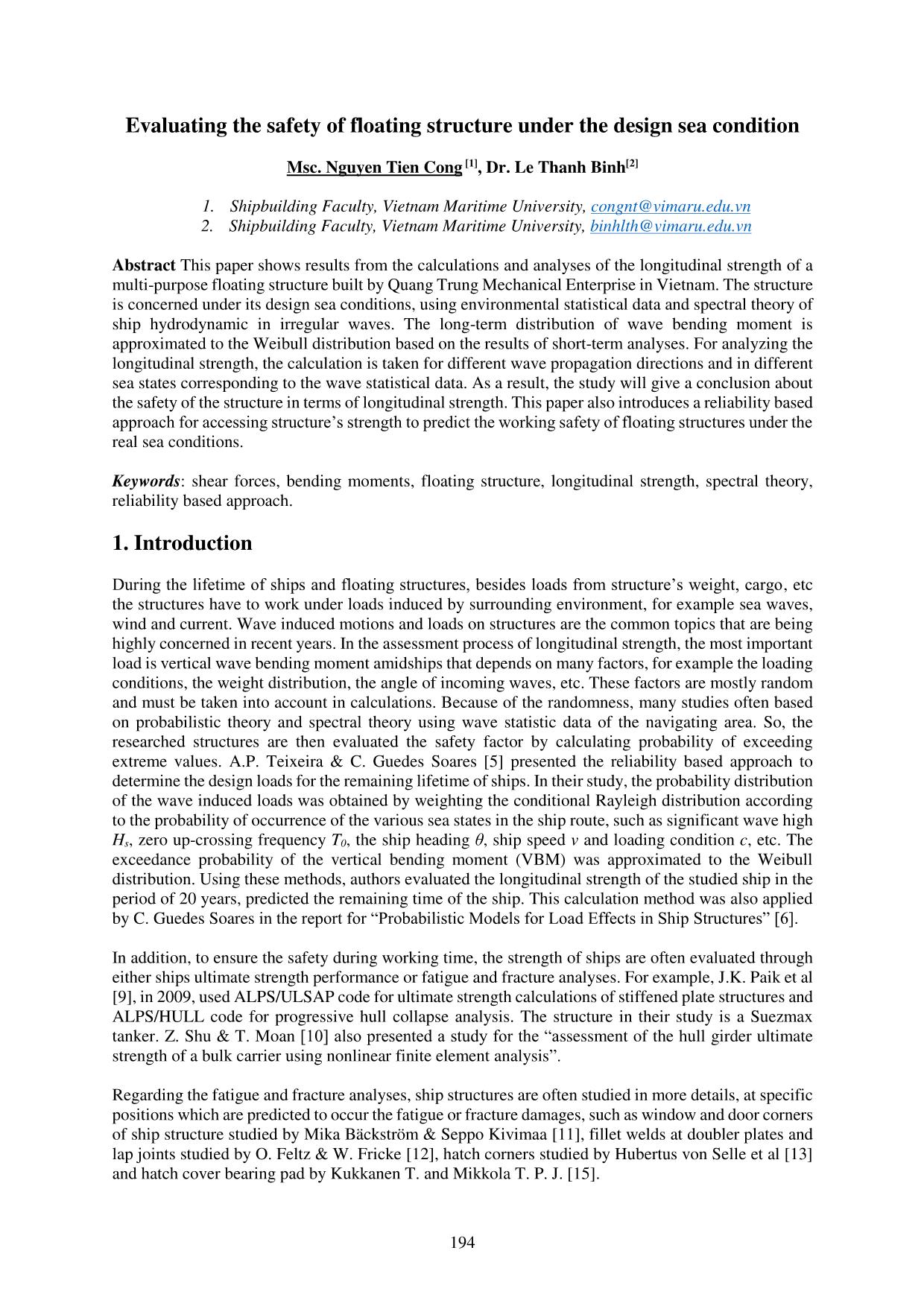
Trang 1
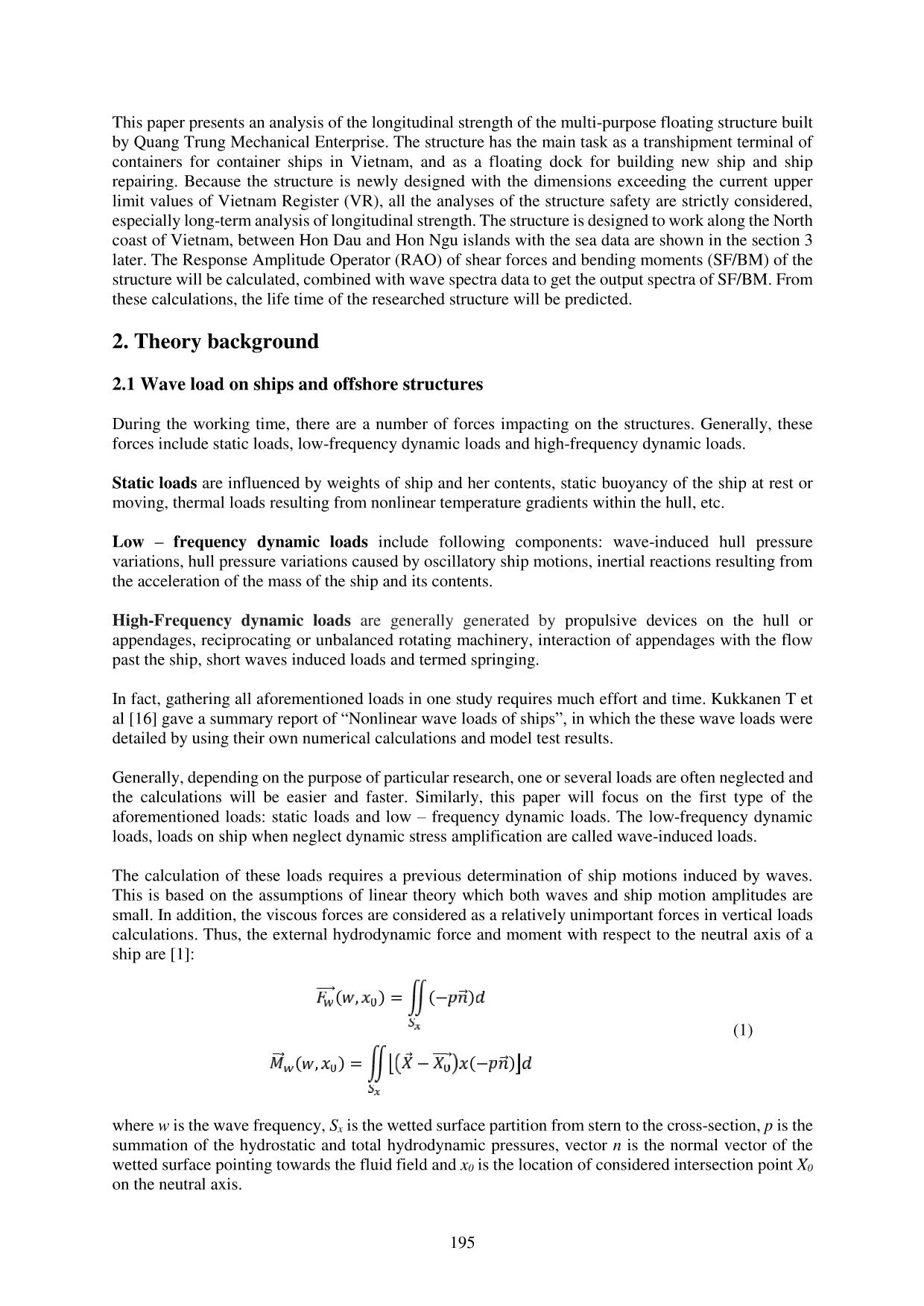
Trang 2
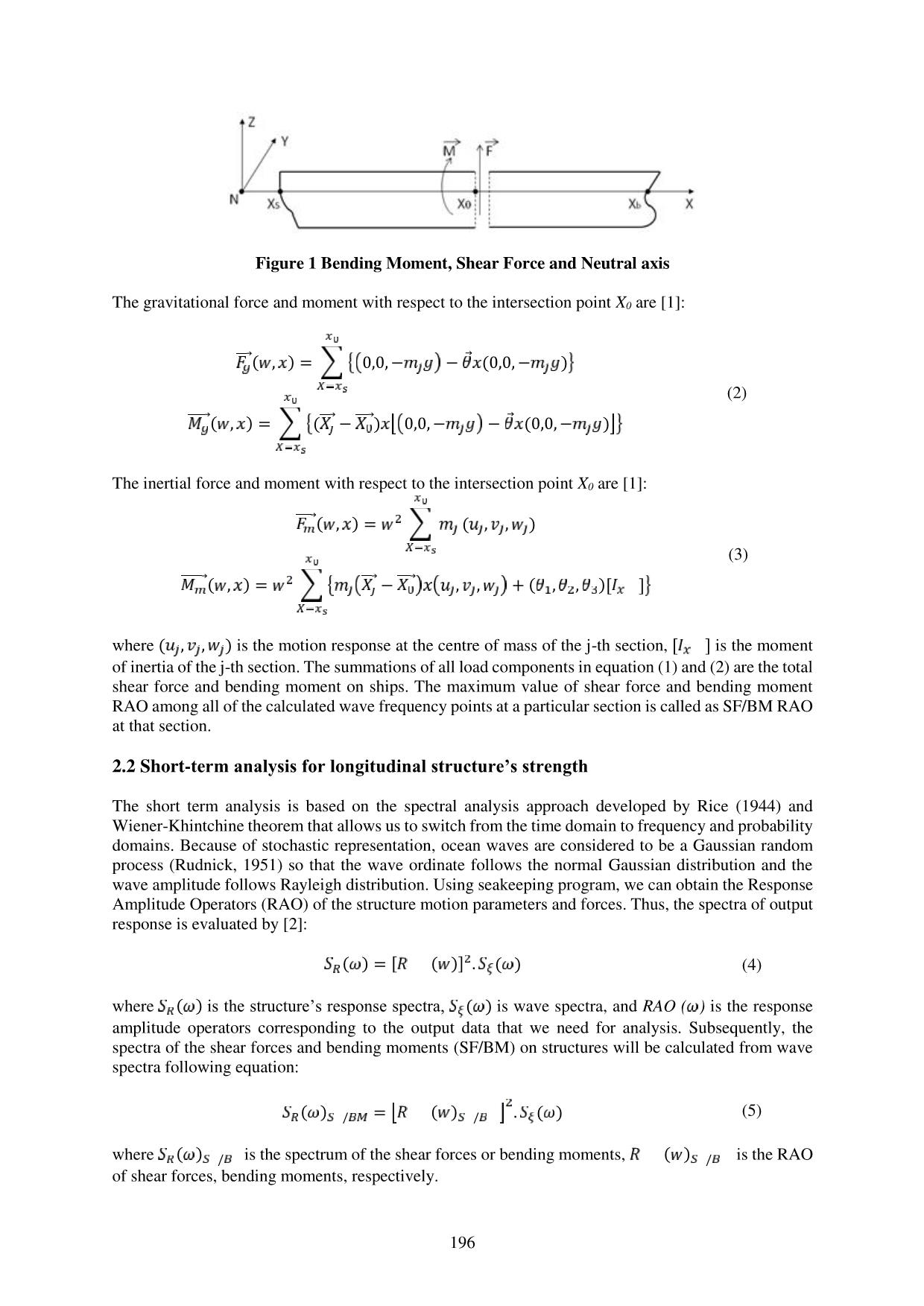
Trang 3
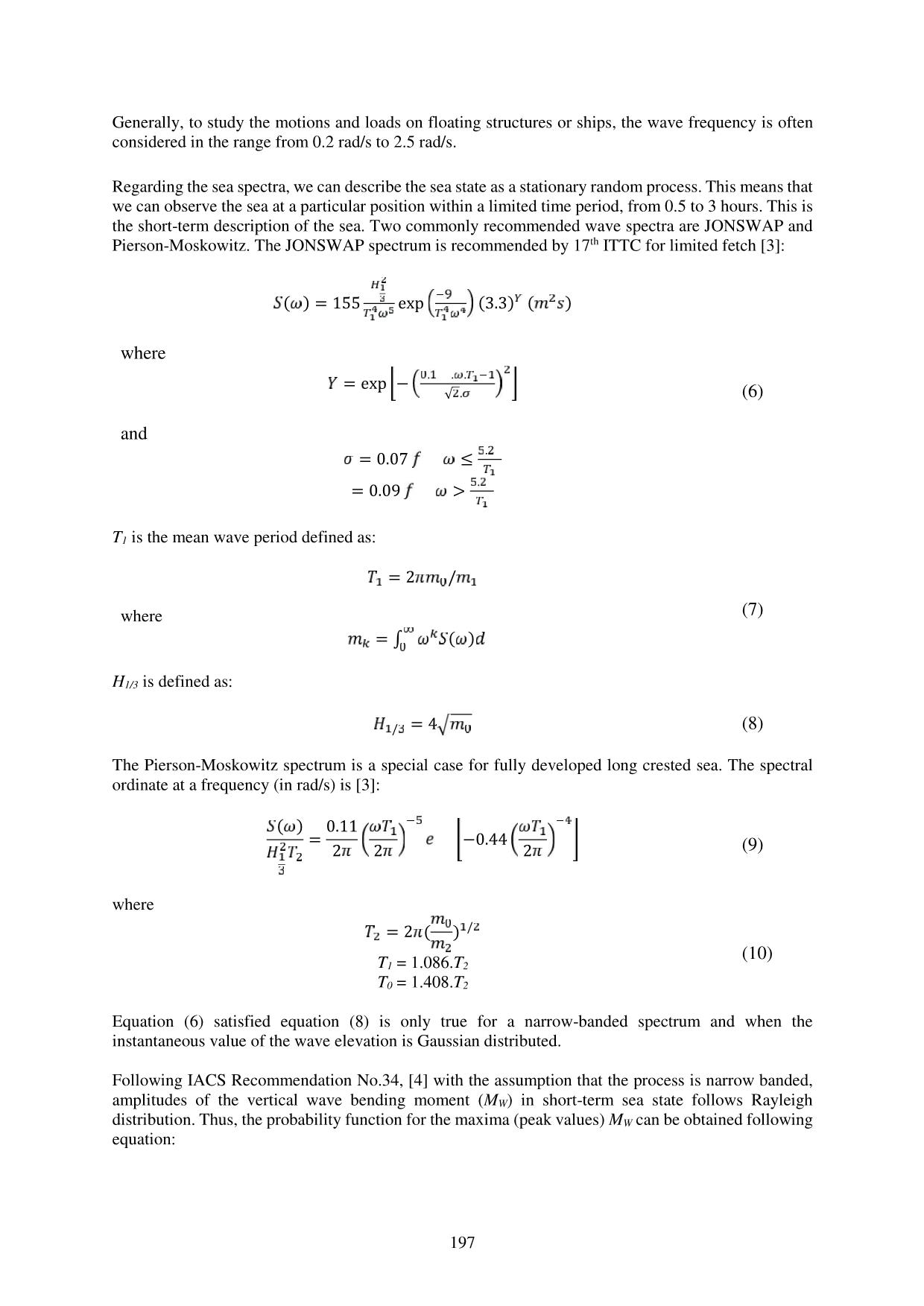
Trang 4

Trang 5
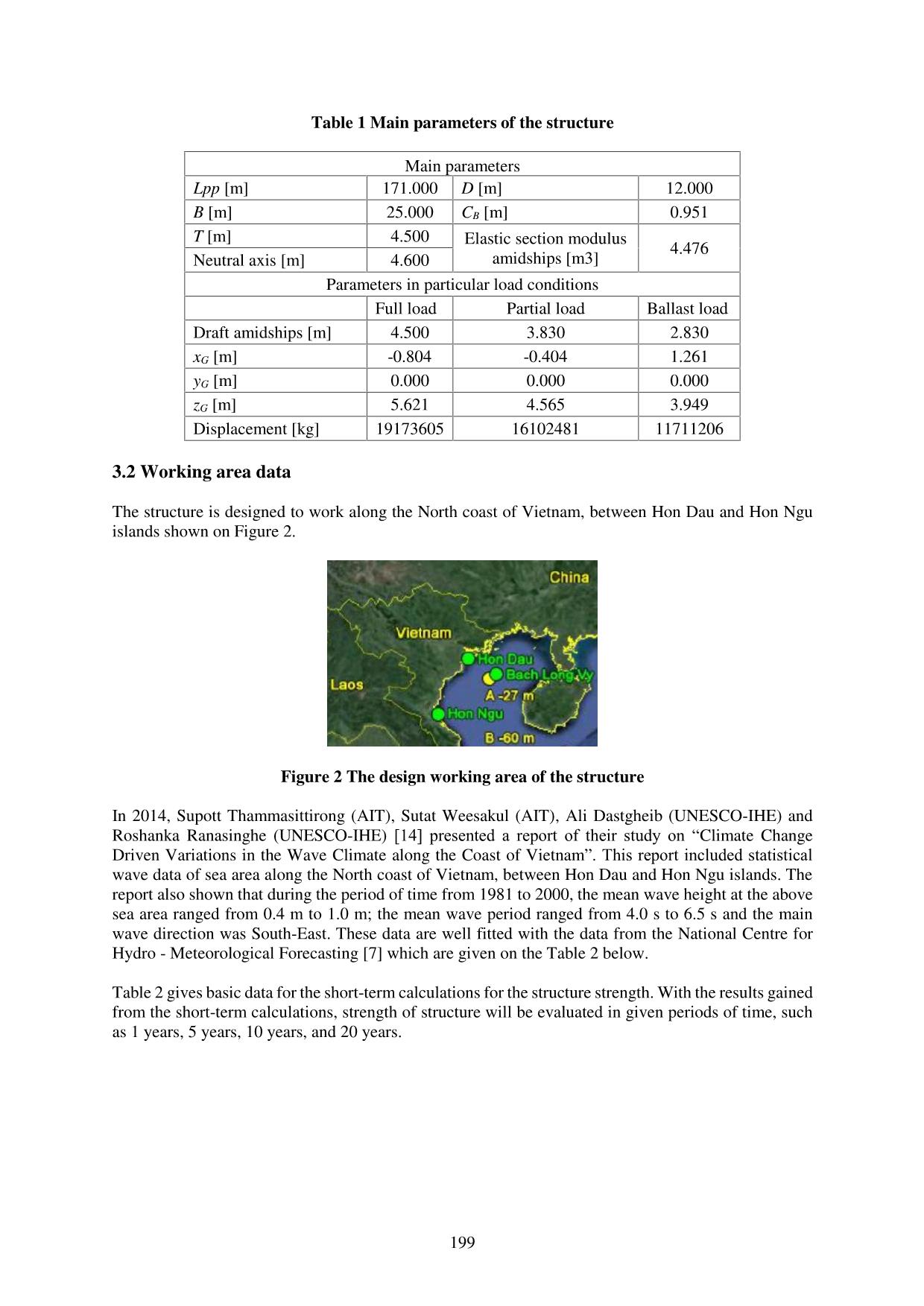
Trang 6

Trang 7
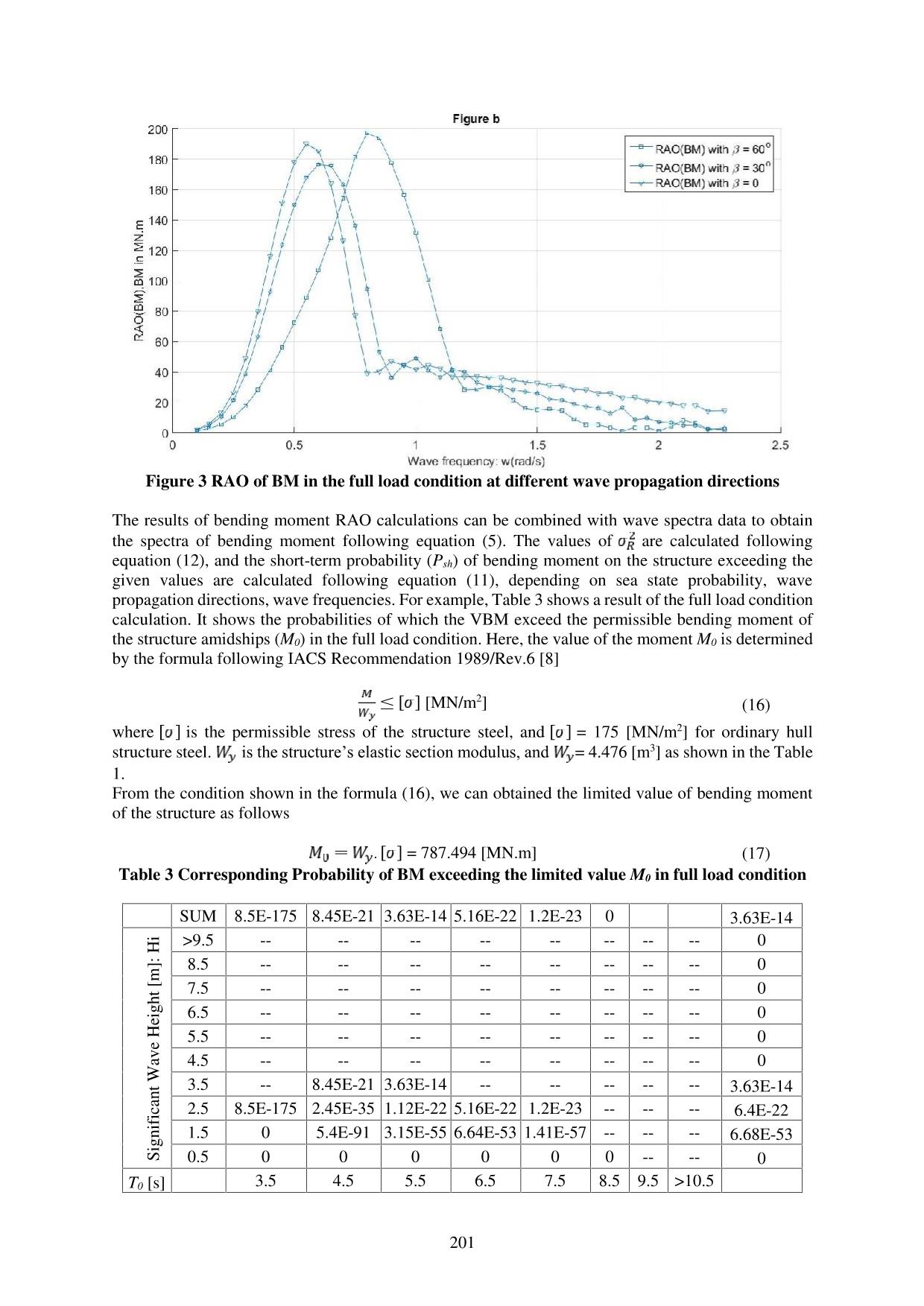
Trang 8
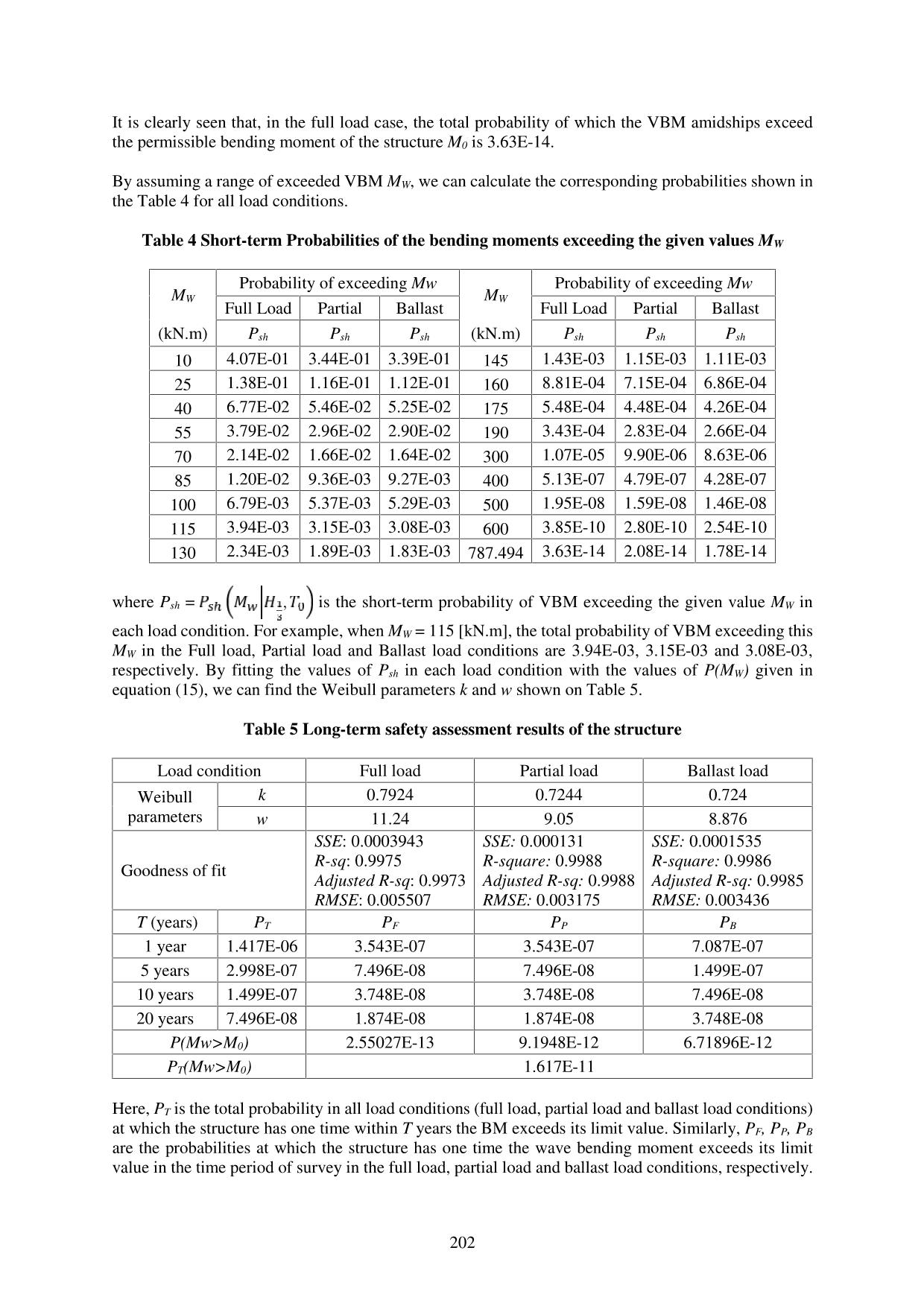
Trang 9
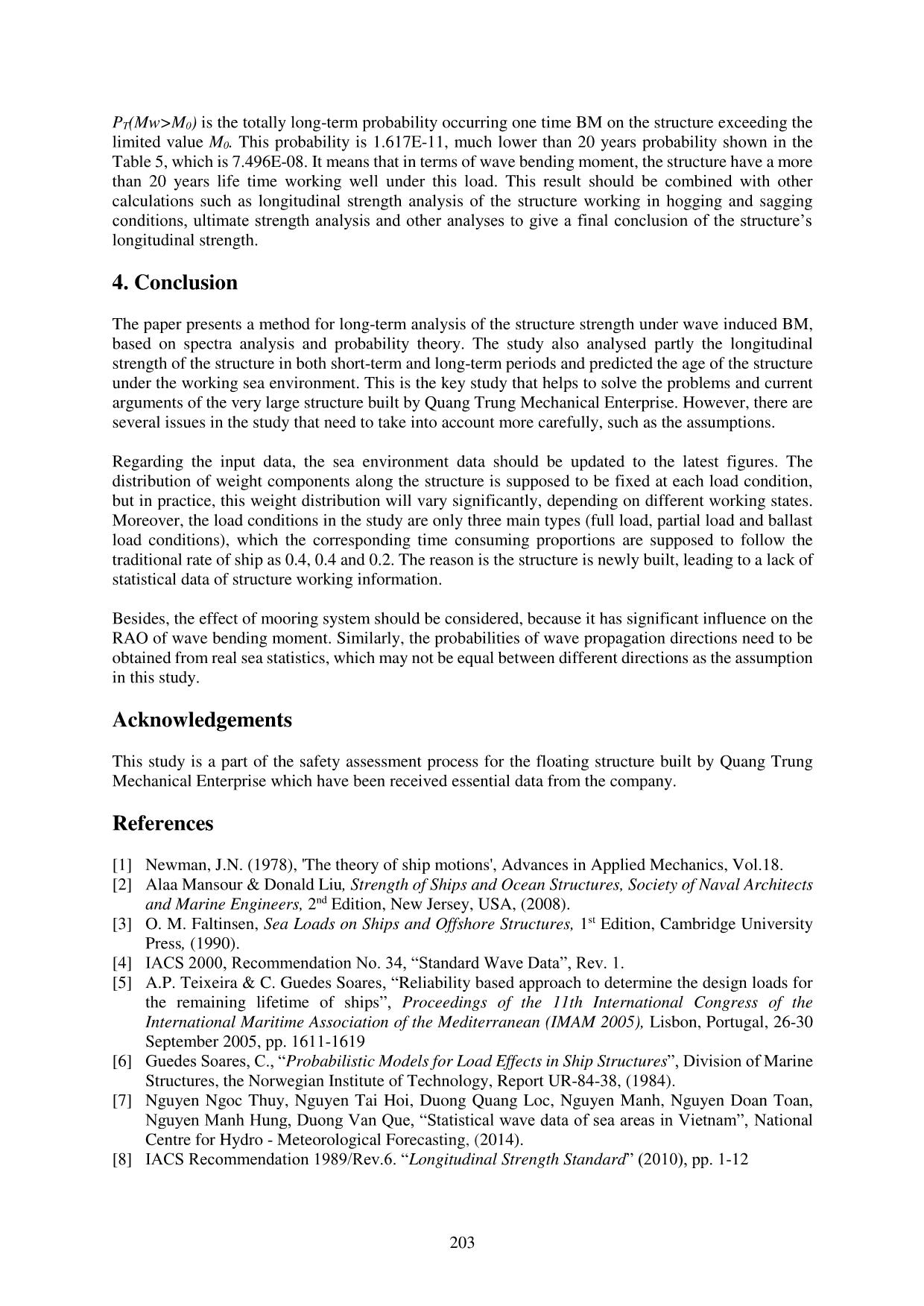
Trang 10
Tải về để xem bản đầy đủ
Tóm tắt nội dung tài liệu: Evaluating the safety of floating structure under the design sea condition
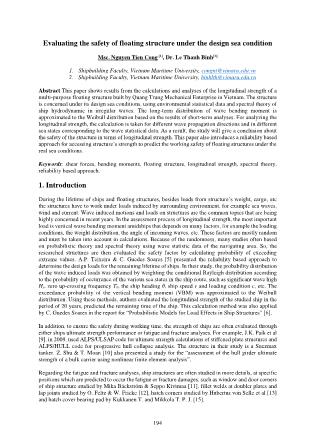
194 Evaluating the safety of floating structure under the design sea condition Msc. Nguyen Tien Cong [1], Dr. Le Thanh Binh[2] 1. Shipbuilding Faculty, Vietnam Maritime University, congnt@vimaru.edu.vn 2. Shipbuilding Faculty, Vietnam Maritime University, binhlth@vimaru.edu.vn Abstract This paper shows results from the calculations and analyses of the longitudinal strength of a multi-purpose floating structure built by Quang Trung Mechanical Enterprise in Vietnam. The structure is concerned under its design sea conditions, using environmental statistical data and spectral theory of ship hydrodynamic in irregular waves. The long-term distribution of wave bending moment is approximated to the Weibull distribution based on the results of short-term analyses. For analyzing the longitudinal strength, the calculation is taken for different wave propagation directions and in different sea states corresponding to the wave statistical data. As a result, the study will give a conclusion about the safety of the structure in terms of longitudinal strength. This paper also introduces a reliability based approach for accessing structure’s strength to predict the working safety of floating structures under the real sea conditions. Keywords: shear forces, bending moments, floating structure, longitudinal strength, spectral theory, reliability based approach. 1. Introduction During the lifetime of ships and floating structures, besides loads from structure’s weight, cargo, etc the structures have to work under loads induced by surrounding environment, for example sea waves, wind and current. Wave induced motions and loads on structures are the common topics that are being highly concerned in recent years. In the assessment process of longitudinal strength, the most important load is vertical wave bending moment amidships that depends on many factors, for example the loading conditions, the weight distribution, the angle of incoming waves, etc. These factors are mostly random and must be taken into account in calculations. Because of the randomness, many studies often based on probabilistic theory and spectral theory using wave statistic data of the navigating area. So, the researched structures are then evaluated the safety factor by calculating probability of exceeding extreme values. A.P. Teixeira & C. Guedes Soares [5] presented the reliability based approach to determine the design loads for the remaining lifetime of ships. In their study, the probability distribution of the wave induced loads was obtained by weighting the conditional Rayleigh distribution according to the probability of occurrence of the various sea states in the ship route, such as significant wave high Hs, zero up-crossing frequency T0, the ship heading θ, ship speed v and loading condition c, etc. The exceedance probability of the vertical bending moment (VBM) was approximated to the Weibull distribution. Using these methods, authors evaluated the longitudinal strength of the studied ship in the period of 20 years, predicted the remaining time of the ship. This calculation method was also applied by C. Guedes Soares in the report for “Probabilistic Models for Load Effects in Ship Structures” [6]. In addition, to ensure the safety during working time, the strength of ships are often evaluated through either ships ultimate strength performance or fatigue and fracture analyses. For example, J.K. Paik et al [9], in 2009, used ALPS/ULSAP code for ultimate strength calculations of stiffened plate structures and ALPS/HULL code for progressive hull collapse analysis. The structure in their study is a Suezmax tanker. Z. Shu & T. Moan [10] also presented a study for the “assessment of the hull girder ultimate strength of a bulk carrier using nonlinear finite element analysis”. Regarding the fatigue and fracture analyses, ship structures are often studied in more details, at specific positions which are predicted to occur the fatigue or fracture damages, such as window and door corners of ship structure studied by Mika Bäckström & Seppo Kivimaa [11], fillet welds at doubler plates and lap joints studied by O. Feltz & W. Fricke [12], hatch corners studied by Hubertus von Selle et al [13] and hatch cover bearing pad by Kukkanen T. and Mikkola T. P. J. [15]. 195 This paper presents an analysis of the longitudinal strength of the multi-purpose floating structure built by Quang Trung Mechanical Enterprise. The structure has the main task as a transhipment terminal of containers for container ships in Vietnam, and as a floating dock for building new ship and ship repairing. Because the structure is newly designed with the dimensions exceeding the current upper limit values of Vietnam Register (VR), all the analyses of the structure safety are strictly considered, especially long-term analysis of longitudinal strength. The structure is designed to work along the North coast of Vietnam, between Hon Dau and Hon Ngu islands with the sea data are shown in the section 3 later. The Response Amplitude Operator (RAO) of shear forces and bending moments (SF/BM) of the structure will be calculated, combined with wave spectra data to get the output spectra of SF/BM. From these calculations, the life time of the researched structure will be predicted. 2. Theory background 2.1 Wave load on ships and offshore structures During the working time, there are a number of forces impacting on the structures. Generally, these forces include static loads, low-frequency dynamic loads and high-frequency dynamic loads. Static loads are influenced by weights of ship and her contents, static buoyancy of the ship at rest or moving, thermal loads resulting from nonlinear temperature gradients within the hull, etc. Low – frequency dynamic loads include following components: wave-induced hull pressure variations, hull pressure variations caused by oscillatory ship motions, inertial reactions resulting from the acc ... of ( ) to 1 − ( ). 3. Long-term safety evaluation of the multi-purpose floating structure 3.1 Parameters of the structure To evaluate long-term safety of the investigated floating structure, the details of the structure parameters as well as structure’s working environment must be provided. Table 1 shows the summarization of the structure’s parameters. Because the structure is newly designed, then all load conditions data during the life time of the structure are still unknown. So, in this study, the load conditions of the structure are supposed to include three main cases: Full load, Ballast load and Partial load, with the corresponding time consuming proportions are 0.4, 0.4 and 0.2 (of the structure’s working time), respectively. 199 Table 1 Main parameters of the structure Main parameters Lpp [m] 171.000 D [m] 12.000 B [m] 25.000 CB [m] 0.951 T [m] 4.500 Elastic section modulus amidships [m3] 4.476Neutral axis [m] 4.600 Parameters in particular load conditions Full load Partial load Ballast load Draft amidships [m] 4.500 3.830 2.830 xG [m] -0.804 -0.404 1.261 yG [m] 0.000 0.000 0.000 zG [m] 5.621 4.565 3.949 Displacement [kg] 19173605 16102481 11711206 3.2 Working area data The structure is designed to work along the North coast of Vietnam, between Hon Dau and Hon Ngu islands shown on Figure 2. Figure 2 The design working area of the structure In 2014, Supott Thammasittirong (AIT), Sutat Weesakul (AIT), Ali Dastgheib (UNESCO-IHE) and Roshanka Ranasinghe (UNESCO-IHE) [14] presented a report of their study on “Climate Change Driven Variations in the Wave Climate along the Coast of Vietnam”. This report included statistical wave data of sea area along the North coast of Vietnam, between Hon Dau and Hon Ngu islands. The report also shown that during the period of time from 1981 to 2000, the mean wave height at the above sea area ranged from 0.4 m to 1.0 m; the mean wave period ranged from 4.0 s to 6.5 s and the main wave direction was South-East. These data are well fitted with the data from the National Centre for Hydro - Meteorological Forecasting [7] which are given on the Table 2 below. Table 2 gives basic data for the short-term calculations for the structure strength. With the results gained from the short-term calculations, strength of structure will be evaluated in given periods of time, such as 1 years, 5 years, 10 years, and 20 years. 200 Table 2 Annual statistical data of the design sea area SUM 559 315 101 20 4 1 0 0 1000 Si gn ifi ca n t W av e H ei gh t [ m ]: H i >9.5 -- -- -- -- -- -- -- -- 0 8.5 -- -- -- -- -- -- -- -- 0 7.5 -- -- -- -- -- -- -- -- 0 6.5 -- -- -- -- -- -- -- -- 0 5.5 -- -- -- -- -- -- -- -- 0 4.5 -- -- -- -- -- -- -- -- 0 3.5 -- 1 1 -- -- -- -- -- 2 2.5 6 11 5 2 1 -- -- -- 25 1.5 73 85 38 9 2 -- -- -- 207 0.5 480 218 57 9 1 1 -- -- 766 T0 [s] 3.5 4.5 5.5 6.5 7.5 8.5 9.5 >10.5 SUM T0- mean [s] 4.10 3.3 Results and discussion The structure is supposed to work in its design sea wave environment with different wave frequencies and propagation directions. These frequencies range from 0.2 rad/s to 2.5 rad/s. The wave propagation angles range from -180o to +180o ( = 30o) with the corresponding probability of each is 1/12, [3]. We also suppose that the weight distribution in each load condition is fixed, the liquid’s sloshing in tanks are neglected, and the structure will generally have 1 month docking for small renovation each year, 3 ÷6 months docking for big renovation every 5 years of working. Figure 3 shows examples of the calculated bending moment RAO at mid-section of the structure in different wave propagation directions. 201 Figure 3 RAO of BM in the full load condition at different wave propagation directions The results of bending moment RAO calculations can be combined with wave spectra data to obtain the spectra of bending moment following equation (5). The values of are calculated following equation (12), and the short-term probability (Psh) of bending moment on the structure exceeding the given values are calculated following equation (11), depending on sea state probability, wave propagation directions, wave frequencies. For example, Table 3 shows a result of the full load condition calculation. It shows the probabilities of which the VBM exceed the permissible bending moment of the structure amidships (M0) in the full load condition. Here, the value of the moment M0 is determined by the formula following IACS Recommendation 1989/Rev.6 [8]≤ [ ] [MN/m2] (16) where [ ] is the permissible stress of the structure steel, and [ ] = 175 [MN/m2] for ordinary hull structure steel. is the structure’s elastic section modulus, and = 4.476 [m3] as shown in the Table 1. From the condition shown in the formula (16), we can obtained the limited value of bending moment of the structure as follows = . [ ] = 787.494 [MN.m] (17) Table 3 Corresponding Probability of BM exceeding the limited value M0 in full load condition SUM 8.5E-175 8.45E-21 3.63E-14 5.16E-22 1.2E-23 0 3.63E-14 Si gn ifi ca n t W av e H ei gh t [ m ]: H i >9.5 -- -- -- -- -- -- -- -- 0 8.5 -- -- -- -- -- -- -- -- 0 7.5 -- -- -- -- -- -- -- -- 0 6.5 -- -- -- -- -- -- -- -- 0 5.5 -- -- -- -- -- -- -- -- 0 4.5 -- -- -- -- -- -- -- -- 0 3.5 -- 8.45E-21 3.63E-14 -- -- -- -- -- 3.63E-14 2.5 8.5E-175 2.45E-35 1.12E-22 5.16E-22 1.2E-23 -- -- -- 6.4E-22 1.5 0 5.4E-91 3.15E-55 6.64E-53 1.41E-57 -- -- -- 6.68E-53 0.5 0 0 0 0 0 0 -- -- 0 T0 [s] 3.5 4.5 5.5 6.5 7.5 8.5 9.5 >10.5 202 It is clearly seen that, in the full load case, the total probability of which the VBM amidships exceed the permissible bending moment of the structure M0 is 3.63E-14. By assuming a range of exceeded VBM MW, we can calculate the corresponding probabilities shown in the Table 4 for all load conditions. Table 4 Short-term Probabilities of the bending moments exceeding the given values MW MW Probability of exceeding Mw MW Probability of exceeding Mw Full Load Partial Ballast Full Load Partial Ballast (kN.m) Psh Psh Psh (kN.m) Psh Psh Psh 10 4.07E-01 3.44E-01 3.39E-01 145 1.43E-03 1.15E-03 1.11E-03 25 1.38E-01 1.16E-01 1.12E-01 160 8.81E-04 7.15E-04 6.86E-04 40 6.77E-02 5.46E-02 5.25E-02 175 5.48E-04 4.48E-04 4.26E-04 55 3.79E-02 2.96E-02 2.90E-02 190 3.43E-04 2.83E-04 2.66E-04 70 2.14E-02 1.66E-02 1.64E-02 300 1.07E-05 9.90E-06 8.63E-06 85 1.20E-02 9.36E-03 9.27E-03 400 5.13E-07 4.79E-07 4.28E-07 100 6.79E-03 5.37E-03 5.29E-03 500 1.95E-08 1.59E-08 1.46E-08 115 3.94E-03 3.15E-03 3.08E-03 600 3.85E-10 2.80E-10 2.54E-10 130 2.34E-03 1.89E-03 1.83E-03 787.494 3.63E-14 2.08E-14 1.78E-14 where Psh = , is the short-term probability of VBM exceeding the given value MW in each load condition. For example, when MW = 115 [kN.m], the total probability of VBM exceeding this MW in the Full load, Partial load and Ballast load conditions are 3.94E-03, 3.15E-03 and 3.08E-03, respectively. By fitting the values of Psh in each load condition with the values of P(MW) given in equation (15), we can find the Weibull parameters k and w shown on Table 5. Table 5 Long-term safety assessment results of the structure Load condition Full load Partial load Ballast load Weibull parameters k 0.7924 0.7244 0.724 w 11.24 9.05 8.876 Goodness of fit SSE: 0.0003943 R-sq: 0.9975 Adjusted R-sq: 0.9973 RMSE: 0.005507 SSE: 0.000131 R-square: 0.9988 Adjusted R-sq: 0.9988 RMSE: 0.003175 SSE: 0.0001535 R-square: 0.9986 Adjusted R-sq: 0.9985 RMSE: 0.003436 T (years) PT PF PP PB 1 year 1.417E-06 3.543E-07 3.543E-07 7.087E-07 5 years 2.998E-07 7.496E-08 7.496E-08 1.499E-07 10 years 1.499E-07 3.748E-08 3.748E-08 7.496E-08 20 years 7.496E-08 1.874E-08 1.874E-08 3.748E-08 P(Mw>M0) 2.55027E-13 9.1948E-12 6.71896E-12 PT(Mw>M0) 1.617E-11 Here, PT is the total probability in all load conditions (full load, partial load and ballast load conditions) at which the structure has one time within T years the BM exceeds its limit value. Similarly, PF, PP, PB are the probabilities at which the structure has one time the wave bending moment exceeds its limit value in the time period of survey in the full load, partial load and ballast load conditions, respectively. 203 PT(Mw>M0) is the totally long-term probability occurring one time BM on the structure exceeding the limited value M0. This probability is 1.617E-11, much lower than 20 years probability shown in the Table 5, which is 7.496E-08. It means that in terms of wave bending moment, the structure have a more than 20 years life time working well under this load. This result should be combined with other calculations such as longitudinal strength analysis of the structure working in hogging and sagging conditions, ultimate strength analysis and other analyses to give a final conclusion of the structure’s longitudinal strength. 4. Conclusion The paper presents a method for long-term analysis of the structure strength under wave induced BM, based on spectra analysis and probability theory. The study also analysed partly the longitudinal strength of the structure in both short-term and long-term periods and predicted the age of the structure under the working sea environment. This is the key study that helps to solve the problems and current arguments of the very large structure built by Quang Trung Mechanical Enterprise. However, there are several issues in the study that need to take into account more carefully, such as the assumptions. Regarding the input data, the sea environment data should be updated to the latest figures. The distribution of weight components along the structure is supposed to be fixed at each load condition, but in practice, this weight distribution will vary significantly, depending on different working states. Moreover, the load conditions in the study are only three main types (full load, partial load and ballast load conditions), which the corresponding time consuming proportions are supposed to follow the traditional rate of ship as 0.4, 0.4 and 0.2. The reason is the structure is newly built, leading to a lack of statistical data of structure working information. Besides, the effect of mooring system should be considered, because it has significant influence on the RAO of wave bending moment. Similarly, the probabilities of wave propagation directions need to be obtained from real sea statistics, which may not be equal between different directions as the assumption in this study. Acknowledgements This study is a part of the safety assessment process for the floating structure built by Quang Trung Mechanical Enterprise which have been received essential data from the company. References [1] Newman, J.N. (1978), 'The theory of ship motions', Advances in Applied Mechanics, Vol.18. [2] Alaa Mansour & Donald Liu, Strength of Ships and Ocean Structures, Society of Naval Architects and Marine Engineers, 2nd Edition, New Jersey, USA, (2008). [3] O. M. Faltinsen, Sea Loads on Ships and Offshore Structures, 1st Edition, Cambridge University Press, (1990). [4] IACS 2000, Recommendation No. 34, “Standard Wave Data”, Rev. 1. [5] A.P. Teixeira & C. Guedes Soares, “Reliability based approach to determine the design loads for the remaining lifetime of ships”, Proceedings of the 11th International Congress of the International Maritime Association of the Mediterranean (IMAM 2005), Lisbon, Portugal, 26-30 September 2005, pp. 1611-1619 [6] Guedes Soares, C., “Probabilistic Models for Load Effects in Ship Structures”, Division of Marine Structures, the Norwegian Institute of Technology, Report UR-84-38, (1984). [7] Nguyen Ngoc Thuy, Nguyen Tai Hoi, Duong Quang Loc, Nguyen Manh, Nguyen Doan Toan, Nguyen Manh Hung, Duong Van Que, “Statistical wave data of sea areas in Vietnam”, National Centre for Hydro - Meteorological Forecasting, (2014). [8] IACS Recommendation 1989/Rev.6. “Longitudinal Strength Standard” (2010), pp. 1-12 204 [9] J.K. Paik, D.K. Kim and M.S. Kim, “Ultimate strength performance of Suezmax tanker structures: Pre-CSR versus CSR designs”, Proceedings of Marstruct 2009, the 2nd International Conference on Marine Structures, Lisbon, Portugal, 16–18 March 2009, pp. 181- 189. [10] Z. Shu & T. Moan, “Assessment of the hull girder ultimate strength of a bulk carrier using nonlinear finite element analysis”, Proceedings of Marstruct 2009, the 2nd International Conference on Marine Structures, Lisbon, Portugal, 16–18 March 2009, pp. 173- 188. [11] Mika Bäckström & Seppo Kivimaa, “Fracture mechanics procedures for assessing fatigue life of window and door corners in ship structures”, Proceedings of Marstruct 2009, the 2nd International Conference on Marine Structures, Lisbon, Portugal, 16–18 March 2009, pp. 239- 245. [12] O. Feltz & W. Fricke , “Experimental and numerical fatigue analysis of partial-load and full-load carrying fillet welds at doubler plates and lap joints”, Proceedings of Marstruct 2009, the 2nd International Conference on Marine Structures, Lisbon, Portugal, 16–18 March 2009, pp. 247- 253. [13] Hubertus von Selle, Olaf Doerk & Manfred Scharrer, “Global strength analysis of ships with special focus on fatigue of hatch corners”, Proceedings of Marstruct 2009, the 2nd International Conference on Marine Structures, Lisbon, Portugal, 16–18 March 2009, pp. 255- 260. [14] Supott Thammasittirong (AIT), Sutat Weesakul (AIT),Ali Dastgheib (UNESCO-IHE), Roshanka Ranasinghe (UNESCO-IHE), “Climate Change Driven Variations in the Wave Climate along the Coast of Vietnam”, UNESCO-IHE, March 2014, pp. 39-73. [15] Kukkanen T. and Mikkola T. P. J., Fatigue assessment of spectral approach for the ISSC comparative study of the hatch cover bearing pad, Marine Structures 17,2004, pp 75-90 [16] Kukkanen T., Summary report of the project: Nonlinear wave loads of ships, VTT Research Report, VTT-R_02391-09, 2009
File đính kèm:
 evaluating_the_safety_of_floating_structure_under_the_design.pdf
evaluating_the_safety_of_floating_structure_under_the_design.pdf

